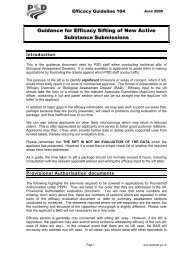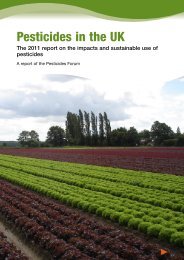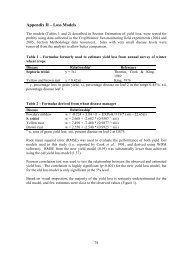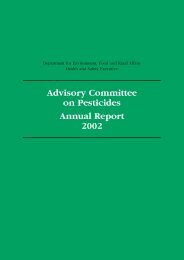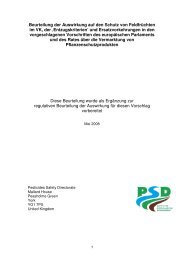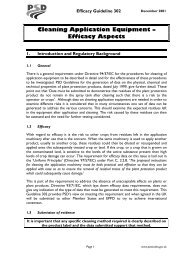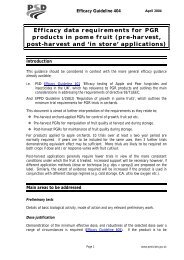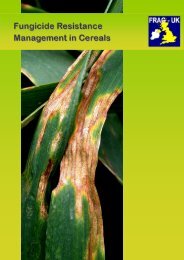Advisory Committee on Pesticides Annual Report 2001
ACP Annual Report 2001 - Pesticides Safety Directorate
ACP Annual Report 2001 - Pesticides Safety Directorate
You also want an ePaper? Increase the reach of your titles
YUMPU automatically turns print PDFs into web optimized ePapers that Google loves.
<str<strong>on</strong>g>Advisory</str<strong>on</strong>g> <str<strong>on</strong>g>Committee</str<strong>on</strong>g> <strong>on</strong> <strong>Pesticides</strong> <strong>Annual</strong> <strong>Report</strong> <strong>2001</strong><br />
were more likely to apply fabric treatments, while the applicati<strong>on</strong> of both<br />
fabric and grain treatments was more prevalent in the South Western regi<strong>on</strong>.<br />
A single commercial store in Wales was encountered in the sample which<br />
applied both fabric and grain treatments.<br />
Approximately 4.7 t<strong>on</strong>nes of pesticides were applied in commercial grain<br />
stores in Great Britain with Scotland, accounting for 38 percent of the weight,<br />
Eastern regi<strong>on</strong> 24 percent, Northern regi<strong>on</strong> 23 percent, Midlands and Western<br />
regi<strong>on</strong> 11 percent, South Western regi<strong>on</strong> three percent, South Eastern regi<strong>on</strong><br />
<strong>on</strong>e percent and Wales less than <strong>on</strong>e percent.<br />
By weight, 80 percent of pesticides was applied to the grain either at or<br />
during storage. Pirimiphos-methyl accounted for 61 percent of the weight<br />
of pesticide applied, either as admixture treatments or incorporated into the<br />
surface or the grain in store. Of all grain treated, 92 percent by weight was<br />
treated with an admixture, the rest receiving surface treatments.<br />
74<br />
The remaining 20 percent of pesticides were applied as fabric treatments,<br />
with pirimiphos-methyl accounting for 53 percent of all fabric treatments and<br />
methyl bromide a further 37 percent.<br />
C<strong>on</strong>tractors applied 50 percent, by weight applied, of fabric treatments but<br />
<strong>on</strong>ly eight percent of the admixture treatments. The use of methyl bromide,<br />
which can be applied <strong>on</strong>ly by c<strong>on</strong>tractors, accounted for the bulk of<br />
c<strong>on</strong>tractor applicati<strong>on</strong>s made to the fabric.<br />
In terms of the number of stores treated, rodenticides were used <strong>on</strong><br />
96 percent of commercial grain stores in Great Britain in 1998. Difenacoum<br />
was the most comm<strong>on</strong>ly occurring rodenticide, being used at 35 percent of<br />
all commercial grain stores, followed by bromadiol<strong>on</strong>e at 25 percent.<br />
Excluding holdings where the product used was unknown, these two active<br />
substances accounted for 68 percent of all recorded occurrences.<br />
Totals of just under <strong>on</strong>e kilogram of active substance and approximately ten<br />
t<strong>on</strong>nes of bait were recorded in the current survey, reflecting the extremely<br />
low percentage of active substance c<strong>on</strong>tained within rodenticide baits.<br />
Since the survey c<strong>on</strong>ducted in 1994/95, the t<strong>on</strong>nage of grain stored had more<br />
than doubled, with some of the increase being due to the storage of<br />
interventi<strong>on</strong> grain, which was minimal in the previous survey period.<br />
The weight of active substances applied had increased by 40 percent, which<br />
is significantly less than the increase in the grain stored since 1994/95. There<br />
had been a c<strong>on</strong>tinued decrease in the number of active substances applied




